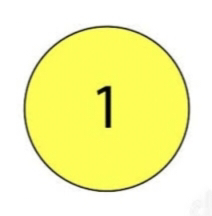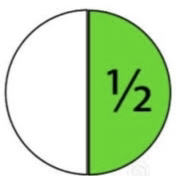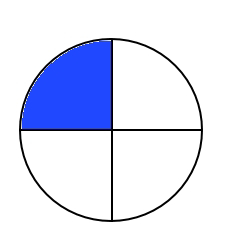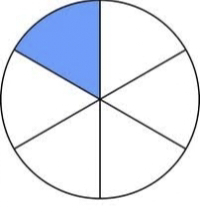A fraction is formed when one thing or a whole thing is divided into equal parts otherwise not.
A fraction is a number representing a part of a whole, when whole is divided into the equal parts.
For example:
Full or One or 1
0ne by two or 1/2 (It is also known as Half.)
When one thing is divided into three parts then it is called one third or 1/3.
One by three or 1/3
When one thing is divided into four parts then it is called one fourth or 1/3.
One by four or 1/4 (It is also known as quarter)
One by six or 1/6
Three by eight or 3/8
Four by six or 4/6
Now recognise and name the every picture in fraction.
There are two part of a fractional number upper part of fractional number is called Numerator and lower part of the fraction is called Denominator and the line which separate the both upper and lower numbers is called separator and spoken as by.
1 < – Numerator
__ < – Separator
2 < – Denominator
Fraction –> Number of parts of a whole is known as fraction When all parts have to be equal in shape and size.
Where the whole may be a single object or a group of objects.
Types of the fraction
(i) Proper fraction
(ii) Improper fraction
(iii) Mixed fraction
(i) Proper fraction
In which fraction numerator is less than the denominator is called proper fraction.
N < D
As ½, ⅓, ¼, ⅕, ⅙, ⅐, ⅛, ⅑, ⅒, ⅔, ⅖, ¾, ⅗, ⅜, ⅘, ⅚, ⅝, ⅞ etc.
(ii) Imroper fraction
In which fraction numerator is greater than the denominator is called proper fraction.
N > D
As. 5/3, 5/2, 6/5,
(iii) Mixed fraction
Which fraction can be written as a combination of a whole and a part is called mixed fractions.
4½, 5⅐
b M
A – = –
c N
M.F. IP.F.
We can convert the improper fraction in mixed fraction and mixed fraction into the improper fraction.
Equivalent fraction
Fractions which represents or shows the same part of a whole are called equivalent fractions.
As
1/2, 2/4, 3/6, 4/8
1/3, 2,/6, 3,/9, 4/12
2/5, 4/10, 6/15
Each proper or improper fraction has many equivalent fractions. To find an equivalent fraction of a given fraction, we may multiply or divide both the numerator and the denominator of the given fraction by the same number.
★ Standard form of a Fraction
Simplest form or lowest form of a fraction is called standard form of a fraction when it's numerator and denominator have no common factor accept 1.
HCF helps the fraction to reduce into the standard form.
An improper fraction can be written as a combination of a whole and a part, and such fraction then called mixed fractions.
Like fraction
The fractions with the same denominator are called like fraction.
Unlike fraction
The fractions with the differ denominator are called unlike fraction.
denominator.
3. Fractions can be shown on a number line. Every fraction has a point associated with it on the number line.
In a proper fraction, the numerator is less than the denominator. The fractions, where the numerator is greater than the denominator are called improper fractions.
5.
4.
5. A fraction is said to be in the simplest (or lowest) form if its numerator and the denomi- nator have no common factor except
Variable
the alphabatic valves letters.
Variabes are called a, b, c, m, p etc
Constant
Numeric Value (or Numbers) cone Called Constant
Terms
Combination of Variably and constant in multiplicable form is Called term . A term is a product of factors.
Factors containing variables are said to be algebraic factors.
Terms which have the same algebraic factors are like terms. Terms which have different algebraic factors are unlike terms.
The coefficient is the numerical factor in the term. Sometimes anyone factor in a term is called the coefficient of the remaining part of the term.
Algebraic expressions are formed from various operations of addition, subtraction, multiplication and division on the variables and constants.
Expressions are made up of terms. Terms are added to make an expression.
Any expression with one or more terms is called a polynomial.
Specifically a one term expression is called a monomial;
a two-term expression is called a binomial;
and a three-term expression is called a trinomial.
to form expressions. For example, the expression 4xy +7 is formed from the variables x and y and constants 4 and 7. The constant 4 and the variables x and y are multiplied to give the product 4xy and the constant 7 is added to this product to give the expression.
2. Expressions are made up of terms. Terms are added to make an expression. For example, the addition of the terms 4xy and 7 gives the expression 4xy +7.
. The term 4xy in the expression 4xy + 7 is a product 3 of factors x, y and 4.
4.
5.
6. Thus, terms 4xy and - 3xy are like terms; but terins 4xy and - 3x are not like terms.
7. In situations such as solving an equation and using a formula, we have to find the value of an expression. The value of the expression depends on the value of the variable from which the expression is formed. Thus, the value of 7x - 3 for x = 5 is 32, since 7(5)-335-3=32.













Post a Comment
Post a Comment